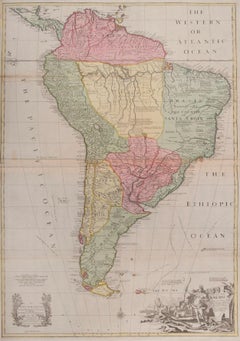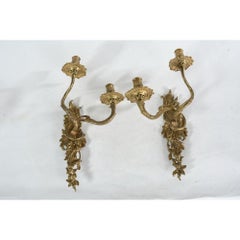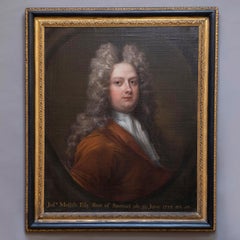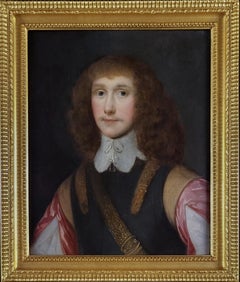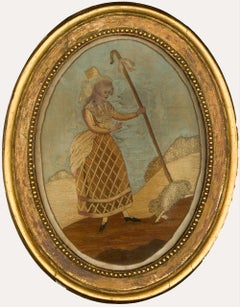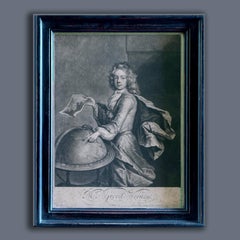Early 18th Century More Art
to
9
7
2
3
1
4
1
Overall Height
to
Overall Width
to
2
217
491
4,757
10,602
66
77
241
306
148
309
355
367
390
1,532
103
4
1
1
5
5
3
2
1
Period: Early 18th Century
Ireland
By John Senex
Located in London, GB
Ireland
SENEX, John.
Ireland Corrected from the Latest Observations Divided into its Provinces, Counties and Baronies. Shewing the Principal Roads, and the Distances of Places, in Common reputed Miles. by Inspection Where Barracks are Erected &c. By John Senex F.R.S.
John Senex F.R.S., the Globe against St Dunstans Church, Fleetstreet, London 1712 [-1728].
John Senex (1678-1740) was one of the foremost mapmakers in England in the early eighteenth century. He was also a surveyor, globemaker, and geographer. As a young man, he was apprenticed to Robert Clavell, a bookseller. He worked with several mapmakers over the course of his career, including Jeremiah Seller and Charles Price. In 1728, Senex was elected as a Fellow of the Royal Society, a rarity for mapmakers. The Fellowship reflects his career-long association as engraver to the Society and publisher of maps by Edmund Halley...
Category
Early 18th Century More Art
Materials
Engraving
Great Britain
By John Senex
Located in London, GB
Great Britain
SENEX, John.
A New Map of Great Britain Corrected from the Observations communicated to the Royal Society at London. By John Senex F.R.S. To the Right Hono[ra]ble William Connelly ESQ. One of the Commissioners of His Maj[es]ties Revenue, Speakerof the Hono[a]ble House of Commons, and one of His Maj[es]ties most Hono[ra]ble Privy Council for Ye Kingdom of Ireland. This Map is dedicated by John Senex.
John Senex F.R.S. 1710 [-1728].
John Senex (1678-1740) was one of the foremost mapmakers in England in the early eighteenth century. He was also a surveyor, globemaker, and geographer. As a young man, he was apprenticed to Robert Clavell, a bookseller. He worked with several mapmakers over the course of his career, including Jeremiah Seller and Charles Price...
Category
Naturalistic Early 18th Century More Art
Materials
Watercolor, Engraving
one of the earliest large-scale English maps of North America
By John Senex
Located in London, GB
one of the earliest large-scale English maps of North America
SENEX, John.
North America Corrected from the Observations Communicated to the Royal Society at London, and the Royal Academy at Paris. By John Senex F.R.S. 1710. To the Honorable Anthony Hammond Esq. One of the Comissioners of Her Maj[es]ties Navy. This Map his humbly Dedicated and Presented by his Obliged Servants.
John Senex F.R.S., 1710 [-1728].
A fine map of North and Central America, with the West Indies.
One of the earliest large-scale English maps of North America. It represents a British attempt to consolidate new information about the region and borrows data from such recently published sources as Delisle’s landmark Carte du Mexique et de la Floride and Carte de la Canada. Senex improves upon De L'Isle's work with a fine depiction of the Great Lakes region and the most accurate definition of the lower Mississippi River and its delta by an English cartographer of the period. Several of the most important and controversial cartographic discoveries of the period are discussed at length, including Lahontan’s mythical Long River and the Salt Lake east of the Country of the Mozeemleck’s, both of which are also depicted in remarkable (albeit fanciful) detail. Sir William Phipps discovery of Spanish wrecks off the coast of the Caicos and Southern Bahamas is also noted. Senex also extended the map’s coverage to the Canadian Arctic and the Terra Incognita above Baffin’s Bay. Present-day Oklahoma and Texas are part of La Floride, considered at the time to be a possession of the French. The Red River and the Indian villages of East Texas are portrayed accurately, but Senex, following Delisle, incorrectly placed many Texas rivers...
Category
Naturalistic Early 18th Century More Art
Materials
Watercolor, Engraving
South America
By John Senex
Located in London, GB
South America
SENEX, John.
South America Corrected from the Observations Communicated to the Royal Society’s of London & Paris. By John Senex. To Edmund Halley. LLD. Savilian Professor of Geometry in Oxford and Fellow of the Royal Society. This Map corrected from His own Discoveries In gratefull Acknowledgement of his Ready assistance to Encourage this Designe is Humbly Dedicated.
John Senex, at the Globe against St Dunstans Church, Fleetstreet, London 1710 [-1728].
John Senex (1678-1740) was one of the foremost mapmakers in England in the early eighteenth century. He was also a surveyor, globemaker, and geographer. As a young man, he was apprenticed to Robert Clavell, a bookseller. He worked with several mapmakers over the course of his career, including Jeremiah Seller and Charles...
Category
Naturalistic Early 18th Century More Art
Materials
Watercolor, Engraving
Paire d'appliques Régence
Located in ROUEN, FR
Paire d'appliques Régence en bronze doré à 2 bras de lumières de forme mouvementée. Joli décor rocaille à motifs feuillagés et fleuris. Ep.XVIIIè. H.43 L.22.
Category
Early 18th Century More Art
Materials
Bronze
Charles Jervas, Portrait of Joseph Mellish
Located in London, GB
Charles Jervas (1675-1739)
Portrait of Joseph Mellish (1675-1733)
Oil on canvas; held in a carved period frame
Dimensions refer to size of frame.
Provenance: Blyth Hall, Nottinghamshire, England; by descent to Sir Andrew Buchanan of Hodsock Priory, Nottinghamshire
In 1635 John Mellish, a merchant tailor of London, bought the estate of Blyth in Nottinghamshire. His son, a wealthy Oporto merchant, dying unmarried, left Blyth in 1703 to a cousin, Joseph Mellish, who became one of Newcastle’s earliest and most important political supporters in the county. He went up to Clare College, Cambridge in 1692 and on to the Inner Temple the following year. He married Dorothea Gore, daughter of Sir William Gore...
Category
Old Masters Early 18th Century More Art
Materials
Oil
Samuel Buck (1696-1779) Ruins of Byland Abbey Yorkshire Engraving Print
Located in London, GB
To see our other views and maps of England - including London, Oxford and Cambridge, scroll down to "More from this Seller" and below it click on "See all from this Seller" - or send...
Category
Realist Early 18th Century More Art
Materials
Engraving
Follower of Jean-Baptiste Monnoyer – Still Life Oil on Canvas
Located in London, GB
Follower of Jean-Baptiste Monnoyer (12 January 1636 – 20 February 1699)
Still Life Oil on Canvas in Later Giltwood Frame
Dimensions refer to size of frame.
Jean-Baptiste Monnoyer ...
Category
Old Masters Early 18th Century More Art
Materials
Canvas, Oil
The History of Japan
By Engelbert Kaempfer
Located in Roma, IT
The History of Japan. Giving an Account of the Ancient and Present State and Government of that Empire; of its Temples, Palaces, Castles and other Buildings...
Category
Early 18th Century More Art
Materials
Etching, Paper
Related Items
Portrait of Gentleman, Thomas Bruce, Earl of Elgin c.1638 Manor House Provenance
Located in London, GB
Titan Fine Art present this picture which formed part of a historic collection of an English aristocratic family, Lord and Lady Sandys at their magnificent baroque and Regency Grade-...
Category
Old Masters Early 18th Century More Art
Materials
Oil, Wood Panel
H 18.9 in W 16.15 in D 1.58 in
Portrait of a Gentleman in Armour and Holding a Baton, Manor House Provenence
Located in London, GB
Titan Fine Art present this accomplished work, from Kilcooley Abbey, Co Tipperary, Ireland. It portrays a gentleman traditionally known as the English military commander and politic...
Category
Old Masters Early 18th Century More Art
Materials
Canvas, Oil
H 56.7 in W 46.86 in D 2.76 in
Oil Portrait of a Victorian Lady, c. 1850
Located in Chicago, IL
Painted in the 19th century, this exquisite miniature portrait wonderfully exemplifies realism in traditional oil painting. The small artwork is painted in the conventional portraiture style of the Old Masters, and achieves soft realism with fine brushwork and a subdued, neutral palette. The half length portrait depicts a fine Victorian woman dressed in all black with a delicate lace collar and bonnet. She wears a ruby broach...
Category
Old Masters Early 18th Century More Art
Materials
Oil
Portrait of an Elegant Lady in a Red Silk Dress, Beautiful Antique Frame c.1720
By Jonathan Richardson the Elder
Located in London, GB
This beautiful portrait was painted circa 1725 and is a fine example of the English eighteenth century portrait style. The artist has chosen to depict the lady against a plain background wearing a simple red silk dress and transparent headdress hanging down the back. The sitter is not shown with jewellery or any other elements to distract the viewer’s attached, thus highlighting the beauty of the young sitter. This restrained manner achieves a sense of understated elegance.
The portrait genre was valued particularly highly in English society. Neither landscapes nor allegorical pictures were ever priced so highly at exhibitions and in the trade as depictions of people, from the highest aristocracy to scholars, writers, poets and statesmen. With the rich colouring and lyrical characterisation, these works are representative of the archetypal English portrait and is are very appealing examples of British portraiture...
Category
Old Masters Early 18th Century More Art
Materials
Canvas, Oil
H 37.41 in W 28.94 in D 1.97 in
Portrait Painting of a Lady with a Miniature of a Boy c.1673-1680, Antique oil
By John Michael Wright
Located in London, GB
In this touching composition a young woman has been depicted wearing a dark coloured dress, draped at the bodice with a gauzy silk scarf and with pearls and large diamonds, over a wh...
Category
Old Masters Early 18th Century More Art
Materials
Canvas, Oil
H 35.04 in W 30.32 in D 1.97 in
Pair (2) Portraits Gentleman & Lady, William & Rachel Helyar c.1656, Civil War
By Robert Walker
Located in London, GB
Portrait of Colonel William Helyar (1621-1698) and Rachel Helyar (c.1633-1678) c.1656
Circle of Robert Walker (act. 1637-1656)
These fascinating portraits, presented by Titan Fine Art, depict Colonel William Helyar, High Sheriff of Somersetshire, and his wife Rachel Helyar nee Wyndham, a daughter and co-heiress of Sir Hugh Wyndham, 1st Baronet (died 1663) of Pilsden Court, Dorset. They are exquisite examples of portraiture during the Interregnum when England was under various forms of republican government.
The history of the seventeenth century is in part the story of the Stewarts and their approach to government and the church; their ebbing and flowing popularity and the disastrous decisions that led to Civil War. But another fascinating dynasty also ruled Britain: the Cromwell’s. Between 1653 and 1659, following the Civil Wars and experimental Commonwealth, Oliver Cromwell governed as Lord Protector followed by his son Richard. Cromwell’s Protectorate is usually imagined as a grey, joyless, military regime. But the reality was rather different. Cromwell presided over a colourful and fashionable court where music and the arts flourished, masques were revived and the first English operas performed. Too often the London of the 1650s is painted as puritanical and repressive in contrast to the vivid, fun-loving capital of the Restoration. Yet, under Cromwell, this was the city where the first coffee houses were opening, where a young Samuel Pepys was embarking on his career as a civil servant with the patronage of one of Cromwell’s councillors and where Christopher Wren was enjoying his new Chair of astronomy at Gresham College, appointed after the personal intervention of Cromwell. When Cromwell was invested as Lord Protector for the second time in 1657, the lavish ceremony in Westminster Hall and procession through London matched any previous coronation for pageantry with thousands lining the streets, bells ringing, bonfires blazing and free French wine flowing through the city.
The gentleman in our portrait is Colonel William Helyar (1621-1698), Sheriff of Somerset and as a Royalist during the English Civil War. As one of the most prominent old families of the South-West, the Helyar’s family roots in Somerset can be traced back to 1616 when the Reverend William Helyar (1559-1645), chaplain to Elizabeth I, who was also a cousin by marriage, purchased the family residence Coker Court in East Coker, Somerset. He married a Devonshire heiress and several estates were bestowed on him as a result. He was a warm supporter of Charles I in the Civil War and was in residence at Exeter in 1643 when the Parliamentarians pillaged the cathedral. Elderly as he was, he boldly resisted them, but was beaten, pelted with mud, and locked up in a ship in the port and only let out on payment of £800. He retired to Coker where he died in 1645. His eldest son Henry died in 1634 and he was succeeded by his grandson, Colonel William Helyar, the sitter in our portrait. Colonel Helyar raised a troop of horse for King Charles I and was a colonel in the king's army. He was at Exeter when it was captured by the Parliamentary forces in 1646 and thus deemed ‘Traitor to the Parliament’. His estates were sequestered, but they were returned and he was discharged and pardoned on payment of £1,522. During the Restoration he was a Sheriff and he also helped James II repel the Monmouth Rebellion.
The companion portrait represents the Colonel’s wife, Rachel Helyar (baptised 24th June 1633 at St Mary Aldermanbury, London – died 1678). She was the youngest daughter and co-heir of Sir Hugh Wyndham, 1st Baronet of Pilsdon Court and Mary Wyndham nee Alanson (Sir Hugh should not be confused with his first cousin once removed from Somerset, also Sir Hugh Wyndham (bef. 1604 - 1684). Rachel is a thirteenth generation descendant of King Henry III.
The couple resided at the family seat of Coker Court (interestingly, within the churchyard, lie the remains of the poet T.S. Eliot who once wrote a poem about East Coker). A marriage settlement in extant shows that the couple were married in 1656; the portraits were most likely painted to mark this important event in the sitter’s lives. Rachel holds roses, the flower of love, and the putto pouring water is representative of her purity, and possibly, the plighting of troth. Colonel Helyar wears a gold wedding band.
The couple had four sons: George, William (MP) (1662-1742), John, and Richard. Colonel Helyar died in December 1697 and was buried at Whitechurch, Dorset 2 Jan 1698.
This period in which this portrait was painted was known as the Protectorate (1653-1659). This period offered relative peace, as the English Civil War ended in 1651. It was an interesting time for portraiture in England and Scotland – in between the great artistic geniuses and dominance of Van Dyke and Peter Lely. Much of the foreign-born artistic talent had fled England and Scotland during the Civil War and the artists that had remained were in great demand, in part due to the newly exposed strata of society wishing to be painted. Sitters on both sides were depicted in portraits in very similar ways. They are not, on the whole, shown as the Roundheads and Cavaliers of popular history. In fact, it is usually impossible to guess their political allegiances from the style of their portrait and their Parliamentarian and royalist iconographies, as portraits on both sides followed the same conventions and looked identical.
Colonel Helyar has been depicted in armour and holding a Marshal’s baton of command, confirming his status. There is a great sense of realism and a particular delicacy, note the finely rendered hand resting on the rapier. Rachel is wearing a satin dress with expansive sleeves and a crimson drapery over her shoulder and held up by her left hand. She wears large pearl...
Category
Old Masters Early 18th Century More Art
Materials
Canvas, Oil
H 51.97 in W 44.1 in D 1.97 in
Dutch Old Master Portrait of Girl aged 9 in Black Dress & Lace Ruff dated 1619
Located in London, GB
Portrait of a Noble Young Girl, aged 9, in a black dress with lace ruff and cuffs, Dated 1619
Circle of Cornelis van der Voort (1576- 1624)
Oil on cradled panel
Presented by Titan ...
Category
Old Masters Early 18th Century More Art
Materials
Oil, Wood Panel
H 57.49 in W 42.92 in D 2.76 in
Portrait of a Lady in Silver Silk Dress & Pearls c.1660, Oil on canvas painting
Located in London, GB
This exquisite work is an accomplished example of the type of portrait in vogue in England during the third quarter of the 17th century. There was a large demand for paintings in England and the demand for portraits was greatest. Many artists worked in this lucrative field, even artists who initially trained in the more respected field of history painting, such as Peter Lely, turned their attention to portraiture to meet this demand. Moreover, it was not uncommon for the British, even for men, to present a gift of one’s portrait to a friend - portraits were first and foremost a memento.
Woman at court often vied with one another in displays of rich and fashionable clothing. The drapery was either painted from the customer’s own clothes or was perhaps a creation using fabrics loosely tacked together in the studio. This was a common practice of Lely and his studio props included swathes of fabric and pieces of cloth. The sitter’s sumptuous attire and gauze scarf, fastened by a large diamond brooch, is of the finest material and is representative of wealth. Pearls were an obligatory accompaniment since at least the 1630s and they are worn in abundance – in her hair, on her attire, as a necklace, and as pear-shaped earrings called unions d’excellence, reflecting the difficulty of finding perfectly matched pearls of such large size. They could range up to 20 millimetres in diameter. Her hairstyle help date the painting to the early 1660’s.
Peter Lely, the son of a Dutch...
Category
Old Masters Early 18th Century More Art
Materials
Canvas, Oil
H 36.62 in W 30.71 in D 1.97 in
Aegidius Sadeler II (1570 1629) 16thC Engraving - Woodland Scene with Travelers
By Aegidius Sadeler II
Located in Meinisberg, CH
Aegidius Sadeler
(Flemish, 1570–1629)
Romantic woodland scene with traveler and his laden mule passing by a seated figure resting on the roadside
• 16th, possibly early 17th century
• Copper plate engraving on laid paper with circular watermark
• Trimmed sheet, ca. 17 x 21 cm
• No bothersome stains, damages or restorations
Worldwide shipping is complimentary - There are no additional charges for handling & delivery.
Aegidius Sadeler also known as Aegidius Sadeler II was a prolific Flemish engraver who was principally active at the Prague court of Rudolf II.
The scene engraved is after an image created by Roelant Savery (1576 - 1639). also known as Roeland(t) Maertensz Saverij, was a Flanders-born Dutch Golden Age painter.
The print was published by the Sadeler family member Marco Sadeler...
Category
Naturalistic Early 18th Century More Art
Materials
Ink, Laid Paper, Engraving
Free Shipping
H 6.7 in W 8.27 in D 0.04 in
Portrait of a Gentleman in Armour and Mauve Cloak c.1740; Louis Tocque, Painting
Located in London, GB
The sitter in this superb portrait, presented by Titan Fine Art, is shown with the grandiloquence characteristic of the eighteenth-century French school of painting. The young nobleman has been portrayed wearing an ingeniously embellished French ceremonial armour, a mauve cloak, and an abundance of cascading curls falling below his shoulders. Our portrait proclaims to every onlooker that this is a superior being.
The manner in which portraits were painted was set out by the terms of the commission and usually marked significant life events such as a betrothal, a death, elevation of rank… but they almost always emphasised the wealth and importance of the sitter. This type of portrait had become a standard format for aristocratic portraiture in Europe during the last quarter of the seventeenth century up to the middle of eighteenth century. Incorporated into the background was often a raging battlefield or a military encampment; our portrait is free from these trappings and contains a dramatic moody sky ensures the viewer focuses mainly on the subject.
The features of the sitter’s face have been captured with great sensitivity, his confident gaze perhaps reflecting the near invincibility afforded by this steel suit. The flamboyance and penetrating sense of character, lending an air of noble expectancy to the composition, seems almost eclipsed by the artist's virtuosic handling of paint. It is not hard to understand why many wealthy sitters commissioned the artist to paint their portraits.
Such fine and ornate armour was not actually used on a battlefield and thus its portrayal in portraiture was largely symbolic of a sitter’s wealth and status as well as a claim of succession to a chivalrous tradition. The style of hair and neckcloth were fashionable circa 1740.
Held in an exquisite eighteenth century carved and gilded frame - a fine work of art in itself.
Louis Tocqué was a very successful French portrait painter active during the Rococo period of art. His work was known for its attention to detail, its portrayal of the character of the sitter, the refined postures, and the delicacy of the rendered draperies. He created both realistic and expressive portraits.
Tocqué was born in Paris in 1696 and trained with the famous portrait painters Hyacinthe Rigaud, Nicolas Bertin, and Jean Marc Nattier whose daughter he later married. He entered the Academy in 1731 and became a full member in 1734 with his portraits of Galloche and the sculptor Jean Louis Lemoine, and he pursued a brilliant career as a portrait painter, receiving numerous commissions from members of the French aristocracy and royalty. His works were highly sought after by collectors of the time, and his reputation earned him the appointment of official portrait painter to the court of France in 1746 – in fact he stayed at most of the courts in northern Europe.
From 1737 to 1759 he exhibited a large number of works at the Salon. Tocqué's paintings can be found in museums and private collections around the world.
Recent sales...
Category
Old Masters Early 18th Century More Art
Materials
Canvas, Oil
H 38.19 in W 33.08 in D 2.76 in
24 Carrot Gold-original realism wildlife sculpture-artwork-contemporary art
Located in London, Chelsea
"24 Carrot Gold" by Henk Jan Sanderman is a delightful ceramic tabletop sculpture that celebrates the whimsy of imagination and the allure of treasure. This original artwork features...
Category
Modern Early 18th Century More Art
Materials
Bronze
Free Shipping
H 19.69 in W 11.82 in D 7.88 in
Portrait of a Lady, Katherine St Aubyn, Godolphin, Cornelius Johnson, Oil canvas
By Cornelius Johnson
Located in London, GB
Titan Fine Art are pleased to present this charming bust-length portrait, which is a good example of the style of portrait painted in England in the second quarter of the seventeenth century. The attire consists of the finest silks, and the full billowing sleeves, bows, and hairstyle help in dating this portrait to circa 1637. The accessory par excellence – pearls – are worn as a necklace and were a very popular accessory. The artist makes no attempt to obey the rules of Baroque and instead sensitively depicts in complete honesty his sitter against a plain wall, and without distracting backdrops and flowing draperies – this work is very redolent of the sumptuous half-length female portraits that Cornelius Johnson...
Category
Old Masters Early 18th Century More Art
Materials
Canvas, Cotton Canvas, Oil
H 32.29 in W 27.96 in D 1.58 in
Previously Available Items
18th Century Silkwork - Little Bo Peep & Her Sheep
Located in Corsham, GB
Well presented in an oval gilt frame with beading detail. On silk.
Category
Early 18th Century More Art
Materials
Tapestry
After Michael Dahl, A 17th Century Mezzotint Portrait of Greville Verney
Located in London, GB
Mezzotint engraved by Robert Williams (active 1680-1704) and sold by John Smith
Greville Verney (died 1707) was a member of the famous Verney family of Middle Claydon, Buckinghamshi...
Category
English School Early 18th Century More Art
Materials
Mezzotint
H 17.25 in W 13.25 in D 1.5 in
Recently Viewed
View AllMore Ways To Browse
Dogs Of Paris
Egg White Used In Painting
New Mexico Carved
Ship Painting 18th Century
Hunt Slonem White
Long Live Vintage
Servant Paintings
Servant Painting
Italy Battle Painting
Jean Michel B
Flowers Under Water
River Of No Return
Fox In Dress
Female Roman Sculpture
Oil Paintings Sporting Scenes
Antique Children Portraits
Military Soldier Painting
Keith Haring Japan



